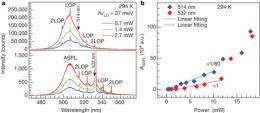January 28, 2013 report
Researchers demonstrate laser cooling of a semiconductor

(Phys.org)—A team of physicists working in Singapore has, for the first time, demonstrated the cooling of a semiconductor using a laser. To achieve this feat, the team, as they describe in their paper published in the journal Nature, used a pump laser at a specified wavelength to annihilate longitudinal optical phonons (LOPs) causing a lowering of the temperature of the cadmium sulphide (CdS) sample.
Scientists have known for years that lasers could be used to cool things down – in recent years they have been used to cool gasses and in some glasses (by adding rare-earth atoms to their crystal matrix.) Cooling in such cases comes about due to a laser interacting with atoms to reduce their motion, which is of course the definition of heat. Cooling down other solids has been a challenge, however, due to the different way heat is represented. Instead of slowing atom movement, researches have sought to impact what are known as phonons – vibrations that propagate through a material. In this new research, the physicists used a laser to annihilate them altogether.
The researchers thought it would be interesting to attempt to cool not just any solid, but a semiconductor due to its importance in the electronics field. They chose CdS because it's so commonly used – generally at room temperatures. They created very slim strips of the semiconductor and placed them on a base of both silicon dioxide and pure silicon – all were held at room temperature. Once everything was in place they fired a laser at the strips, varying the wavelength. At just the right wavelength, they found that the laser light was able to successfully annihilate the phonons, lowering the temperature of the test strips by 40 Kelvin. The heat wasn't lost of course, instead it was converted to photons, which were emitted as light as the laser was fired.
To ensure that the reduction in temperature came about due to interactions between photons and phonons, the team ran the experiment at different wavelengths, and noted that as expected, the result was an increase in temperature, rather than a decrease. And because the same excitation modes exist in other semiconductors of the same type, the researchers are confident that they too could be cooled via the same method, leading perhaps, to new ways of cooling electronics.
More information: Laser cooling of a semiconductor by 40 kelvin, Nature 493, 504–508 (24 January 2013) doi:10.1038/nature11721
Abstract
Optical irradiation accompanied by spontaneous anti-Stokes emission can lead to cooling of matter, in a phenomenon known as laser cooling, or optical refrigeration, which was proposed by Pringsheim in 1929. In gaseous matter, an extremely low temperature can be obtained in diluted atomic gases by Doppler cooling, and laser cooling of ultradense gas has been demonstrated by collisional redistribution of radiation. In solid-state materials, laser cooling is achieved by the annihilation of phonons, which are quanta of lattice vibrations, during anti-Stokes luminescence. Since the first experimental demonstration in glasses doped with rare-earth metals, considerable progress has been made, particularly in ytterbium-doped glasses or crystals: recently a record was set of cooling to about 110 kelvin from the ambient temperature, surpassing the thermoelectric Peltier cooler. It would be interesting to realize laser cooling in semiconductors, in which excitonic resonances dominate, rather than in systems doped with rare-earth metals, where atomic resonances dominate. However, so far no net cooling in semiconductors has been achieved despite much experimental and theoretical work, mainly on group-III–V gallium arsenide quantum wells. Here we report a net cooling by about 40 kelvin in a semiconductor using group-II–VI cadmium sulphide nanoribbons, or nanobelts, starting from 290 kelvin. We use a pump laser with a wavelength of 514 nanometres, and obtain an estimated cooling efficiency of about 1.3 per cent and an estimated cooling power of 180 microwatts. At 100 kelvin, 532-nm pumping leads to a net cooling of about 15 kelvin with a cooling efficiency of about 2.0 per cent. We attribute the net laser cooling in cadmium sulphide nanobelts to strong coupling between excitons and longitudinal optical phonons (LOPs), which allows the resonant annihilation of multiple LOPs in luminescence up-conversion processes, high external quantum efficiency and negligible background absorption. Our findings suggest that, alternatively, group-II–VI semiconductors with strong exciton–LOP coupling could be harnessed to achieve laser cooling and open the way to optical refrigeration based on semiconductors.
Journal information: Nature
© 2013 Phys.org




















